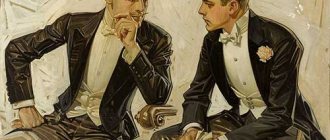Every organization, regardless of the type of activity, has a manager and a leader. And most often these are different people. Leadership, or formal leadership, is a position of authority that is independent of personality traits. In other words, it is the power conferred by official position. Informal leadership is characterized by a set of qualities with the help of which effective influence on people is exercised. An informal leader does not always occupy leadership positions, but at any moment the staff will follow him against the administration of the enterprise.
Not every person is capable of becoming a leader. Many experts suggest that leadership skills come naturally. Of course, in the process of socialization a person acquires the missing abilities and qualities. As an individual matures and gains experience, his talent for leadership increases.
The Essence of Leadership
Leadership is a key component of effective leadership. It is a process of managerial relationships based on a combination of sources of power and aimed at motivating people to achieve goals. There are two main types of leadership: formal and informal. In the first case, employees are under the influence of a person who occupies a high position. In the second case, the impact on people is through personal abilities, skills and qualities.
A formal and informal leader in one person is a rather rare situation, but in most cases it is optimal. Here one cannot ignore the characteristic feature of Russians. If a boss treats his subordinates well and meets them halfway, then the return will be similar. Employees are ready to follow such leaders at any time.
Formal and informal leadership: differences
Choleric - what kind of person is this?
Attention! The main difference between an informal leader and a formal leader is that this status is assigned to him by the team itself. A formal leader is a manager, a person who holds an administrative position in an enterprise. A leadership position cannot endow a person with certain qualities.
An informal person differs from an official leader in the following points:
- There is always a leader in the team. If this post becomes vacant, the vacancy is quickly filled by one or another candidate. The informal appears spontaneously; it is impossible to control this process.
- Formal leadership is a stable structure. Informal leadership is a temporary phenomenon.
- The boss always has sanctions in his hands. The leader has no sanctions that he can apply to colleagues if they refuse to do as he says.
- An unofficial leader maintains his position thanks to his strong qualities. The manager heads the enterprise in accordance with his job description.
- It is easier for a manager to maintain a leading position than for an informal worker, because the production hierarchy is recognized by all employees.
Director's authority
- The manager regulates the production relationships of employees, and the informal influences the interpersonal relationships in the team.
- When making management decisions, the director takes into account many factors, weighs and analyzes, and sometimes calls his deputies to a meeting. Administrative decisions take into account the interests of not only a particular enterprise, but also the interests of other companies. The leader makes decisions individually and directly. His decisions are based on the interests of the members of a particular team.
Informal leader: who is he?
The organizational structure of an enterprise is usually clearly structured. Looking at it, you understand what positions exist in the company and what people occupy them. Informal leaders are people who do not occupy a high position in the organization, but have influence over employees.
The opinion of such people (or one person, it depends on the company) is always regarded as the most important. Colleagues, regardless of their authority and positions, ask for advice in a given situation. A leader in most cases is charismatic and attractive, which allows him to stand out from the crowd.
Prerequisites for becoming a person ready to lead others:
- work experience, availability of professional skills and abilities;
- broad outlook, knowledge in various fields;
- the ability to start a conversation and win people over;
- confidence, self-control, ability to overcome difficulties.
The role of the informal leader in an organization can hardly be overestimated. The general mood of employees depends on it, and the actual manager should not turn a blind eye to this. A good option would be to establish relationships with authoritative people in the company, especially if the manager came after them.
Kinds
Informal leadership groups share common qualities but have differences. There are 5 varieties in total.
- Organizer. Such a leader deals with organizational issues. He establishes time management, draws up plans and schedules, and organizes a clear distribution of responsibilities. He may not be emotional and charismatic enough, due to which his ideas may remain unrecognized, although useful.
- The shirt guy is a person endowed with good imagination; he always has a lot of ideas in stock. He is the life of the party. He has strong energy and charm; his ideas almost always impress everyone. What sets him apart is that he can inspire the team to carry them out. The performance of such people directly depends on their mood and approval from colleagues. He communicates with both his colleagues and management on equal terms.
- A rebel - such an employee always knows at what moment and what needs to be said, and knows how to correctly express his thoughts. He often argues and proves that he is right to his boss. Such a person is a fighter for justice. He constantly defends someone’s interests and provokes riots, arouses affection among his colleagues, and if he quits due to a conflict with his boss, other employees of the company may leave after him.
- The conductor is the first person a manager turns to if he does not want to build relationships with his employees, but wants to convey information to them and get the necessary reaction. Such people are distinguished by their friendliness and won the trust of others, therefore they are good organizers of productive work. They cannot be called absolute leaders, because independent decisions are more difficult for them than carrying out instructions from their boss.
- A gray cardinal is an employee who does not claim leadership, but has influence in the team. He is attentive to detail, and this gives him the ability to manipulate people. This is a supporting character, but, being in the shadows, he successfully leads the process.
Signs of identifying a leader
The so-called cardinal gray is not always as obvious as one might imagine. Often, the head of an organization does not know who exactly influences employees. To find out, you need to tread carefully and not attract too much attention. An informal leader in a group has the following characteristics:
- The most sociable person. It will take a little time to determine the most sociable employee. Most often, he has the ability to easily find a common language with people of any age and temperament.
- Authority. It is necessary to find out who people constantly turn to for advice, asking for help with something or solving a problem. Seniority and work experience play an important role here.
- Confidence and organizational skills. In most cases, the ideological leader expresses disagreement with controversial decisions of management and acts as a representative of the team.
- Good attitude towards both the entire team and each person. In the process of work, this can be determined if he goes to lunch or to the smoking room with different people.
Informal leaders in an organization usually appear when an unexpected situation arises, for example, a project deadline is running out or an important employee gets sick. Then one or more people take the initiative and organize the work, raising their authority. Subsequently, they will be contacted for advice.
Support or problem?
A destructive positive or negative leader in a children's group, or in a society of adults, can become either a source of constant problems or the key to rhythmic, calm and productive communication/work.
Depending on the real influence of the leader on the entire team, the following types of unrecognized leaders can be distinguished:
- Constructive: such a person is excellent at realizing common interests, helping new employees quickly adapt to new working conditions, and demonstrates excellent productivity. It has a positive impact on the performance of individuals and the entire organization as a whole;
- Destructive: such leaders are able to organize any types of conflicts with their superiors, challenge management decisions, undermine their authority and reduce the effectiveness of all work.
Role of an informal leader
Experts say that the appearance of such people is inevitable. Due to his busy schedule, the manager cannot regulate internal relationships in the team, and one of the employees comes to his aid. In addition to his professional qualities, he can bring people together and solve interpersonal problems.
An informal leader in a team can play different roles. This depends on many factors, ranging from leadership style to personal qualities. There are five main roles of leaders:
- Innovator. Such a person can be called an idea generator in another way. These are the type of people who constantly come up with something new and are ready to immediately put it into practice. They are indispensable when organizing any event or introducing new equipment.
- Communicator. A sociable person who is always surrounded by people. He usually has a good sense of humor and is ready to offer advice.
- Crisis manager. The strengths of such a leader manifest themselves in difficult stressful situations. He is able to unite people and direct their thoughts in the right direction. He often finds a solution to this problem, but in ordinary life he does not stand out in any way.
- Inspirer. The influence of an informal leader in this role cannot be called decisive, but his emotional impact gives a positive result.
- Eminence grise. This is the most dangerous type of leader. These people have good knowledge in psychology. Remaining in the shadows, they are able to control the work of not only ordinary employees, but also management.
Let's look back
History shows that behind almost every leader there was not one support representative, but a whole group. Let's remember three striking examples of informal leaders, the so-called gray cardinals.
Francois Leclerc du Tremblay
Better known as Father Joseph or the Gray Cardinal, so nicknamed for the color of his cassock, he is a monk of the Capuchin Order, actually a cardinal only in the last year of his life.
Father Joseph was the constant companion of the true Red Cardinal Armand Jean du Plessis Richelieu (better known as Richelieu), carried out the Cardinal's secret orders, resolved important issues related to political background, espionage connections, influencing the conduct of the Thirty Years' War (1618-1648). It is obvious that Richelieu had reasons to trust the monk, because the figure of Father Joseph is historically recognized as an example of a righteous Catholic and patriot.
By the way, the famous painting by Charles Edouard Delo is notable for its depiction of these two figures. Its title (“ Richelieu and his cats ”) also emphasizes a certain mystery of the image of Father Joseph, who did not have any important title, but at the same time, as can be seen from the picture, was literally Richelieu’s right hand:
Heinrich Johann Friedrich Ostermann
Russian “version” – Andrei Ivanovich Osterman (1686-1747).
Not only France was famous for the presence of gray cardinals. The Russian Empire was also no exception. Osterman managed to maintain prominent positions under three Russian tsars - Peter I, Catherine I, Anna Ioanovna. And the path of young Henry began in Germany, where he was born, but was forced to flee first to the Netherlands and then to Russia, because... killed his opponent in a duel.
Possessing knowledge of several languages, Osterman passed for a cunning, wise, dangerous man who was fluent in the art of pretending and lying. At the same time, abstracting from his personal characteristics, we note that it was this person who became an important diplomatic link in the preparation of the Peace of Nystadt, which marked the end of the Northern War (1700-1721). Osterman was also one of the authors of the 1726 Treaty of Vienna between Russia and the Holy Roman Empire.
The end of the politician was not so pleasant, because... Elizaveta Petrovna, once his enemy and rival, sent him into exile, where Osterman ended his journey.
Mikhail Andreevich Suslov
The gray cardinal of the Soviet period in the history of our state. Mikhail Andreevich Suslov also carried out his activities under three leaders of the USSR - J.V. Stalin, N.S. Khrushchev and L.I. Brezhnev.
After joining the CPSU in 1921, the young man’s career developed rapidly - he began to be responsible for the most important front of work during the Soviet era - the ideological sphere. Already under Nikita Sergeevich, it is believed that it was Suslov who insisted on sending national troops to Hungary. Under Leonid Ilyich, the sphere of authority of politics expanded, because he was responsible for education, culture, and censorship. Suslov was known as a conservative and dogmatist; persecution of the intelligentsia, arrests of dissidents, exile of famous writers and scientists are associated with his name.
It is obvious that, being a close associate of such different and strong leaders of a powerful state, Mikhail Suslov possessed a number of special qualities - cunning, depth of thinking, pragmatism, and at the same time he always remained in the shadows, as befits a true eminence gray.
As you can see, throughout history, even the brightest formal leaders have faced the problem of the emergence of an informal leader, but thanks to the right strategy of behavior on both sides, they managed to come to mutual benefit and enlist each other's support.
The moral of these examples is: don't get rid of informal leaders. The only real signal for this step is that the informal leader begins to fight. In this case, you need to say goodbye to him, no matter what the cost. In other cases, you need to look for compromises and choose the strategy of a real leader [I. Ryzov, 2020].
How can a leader's abilities be used to develop an enterprise?
The manager and the informal leader are not always on good terms. Identifying an inspiration is not an easy task, but making sure that his qualities are aimed at the development of the organization is even more difficult. In order to effectively interact with a leader, a leader should use the following methods:
- Encouraging initiative. And it doesn’t have to be done in the form of a monetary reward. Conversation, verbal praise, consultation will be sufficient reasons to improve the relationship.
- Recognition of authority. Formal and informal leaders, through mutual efforts, can reach unprecedented heights.
- Openness towards the team. It is necessary to involve workers in the discussion of a particular problem. If there is complete trust between the team and the leader, then the need for an informal leader will disappear on its own.
An example to follow
A leader may not be the most valuable employee, but he will always be the talk of his colleagues. His decisions, actions, proposals and initiatives, views and judgments will be discussed and set as an example. This is especially noticeable when there is no compelling reason to look for authorities, but still the same name comes up in conversations every now and then. Often, bosses, despite their status, envy leaders because this casts a shadow on their personal ambitions, but an experienced and wise leader will look for practical application of the situation, and not pointlessly come out with anger.
Try to identify the informal leader and be sure to find a common language with him in the very first days at the new place of work. They take an example from him, which means that his attitude is almost a verdict.
Our students note that the undoubted advantage that psychological training in the psychology of communication gives them is the opportunity to receive an objective assessment of their behavior from the outside. As they say, you will see a speck in someone else’s eye, but you won’t even notice a log in your own. Sign up for a trial lesson
Leader type: “conductor”
There are four main types of leaders, which were formed according to motivational and behavioral characteristics.
“Conductor” is great for interacting with company management. The boss chooses for him a certain path along which the informal leader should lead people. He is motivated by a sense of significance and importance in the organization. The “conductor” is quite friendly and hardworking by nature.
Such people can encourage others to take action and convey to them their own desire to achieve a certain result. A middle manager is the most acceptable position for a “conductor,” since he is ready to slowly but surely climb the career ladder. This type of leader willingly organizes the work of people within the framework of a clear task. Those areas where you need to take full responsibility are beyond the control of “conductors”.
Don't pretend
Don't try to seem like someone you're not. You can aim to be a leader and declare your ambitions, but you should not mechanically demonstrate leadership qualities. Be considerate of others and behave naturally.
“True confidence is seen when a person understands what he wants. He doesn't have to convince himself that he will be a leader. He takes steps appropriate to his position,” says Konstantin Poshchenny.
A strong professional who is not afraid to take responsibility and knows how to work in a team comes to the status of a boss naturally. For example, newcomers appear in the company, and more experienced employees grow - they become mentors for beginners or assemble their own team. It will not be possible to artificially create the image of a professional, because the lack of experience will be revealed at the first difficulties in work. If you are employed in a field where they are focused on real results, confirm your level with real achievements.
Shirt guy
A friendly, emotional person who is able to charge other people with positivity. Such an informal leader is excellent for influencing specific people who, for various reasons, do not want to complete the task.
With the help of charm and attractiveness, he can sow positive emotions within the team. It is almost impossible to refuse him; even the most boring and uninteresting work will sparkle with new colors in his presence. The motivation for such a leader is a feeling of equality with his superiors. It is important for him to understand that he is able to influence people.
What to do with a destructive leader
It often happens that an informal person causes discord in the relationship between superiors and subordinates. Destructive leadership not only spoils the psychological climate of the team, but also brings financial losses to the company. To correct the situation, the director needs to use some tricks:
- The initiative of the informal must be intercepted and his activity directed in the right direction. At the same time, do not scold him, but praise him, and emphasize that the company is interested in him.
- An informal leader knows the peculiarities of relationships between colleagues, and therefore is able to help them get ready for work. It can also provide support to a depressed employee. In conflict situations, employees consider his opinion authoritative, so he can resolve a quarrel without bringing the matter to a discussion in the director’s office.
- It is necessary to build democratic relationships with subordinates. Taking into account the opinions of subordinates in resolving work issues will help establish discipline and reduce the likelihood of the spread of rumors and gossip.
Informal leadership is a phenomenon that appears in production teams due to the innate qualities and abilities of a person. Management needs to build partnerships with the informal leader, then his presence among subordinates will provide the company with high productivity, retention of staff and consistently high profits.
The benefits of a leader for a team
Eminence grise
An informal leader of this type is a mysterious person. On the one hand, it can be useful to management, as it can easily cope with the task. Moreover, to solve the problem he uses unexpected and effective steps. But on the other hand, these people are so cunning that they can use the leader for their own purposes.
The cardinal gray is most often quite reserved and uncommunicative, but remembers even the most insignificant details with which he can manipulate people. He wants to remain in the shadows and know for himself that he has a huge influence on the organization.
Video
Drill-driver DEKO GCD12DU3 Li-ion, 1x1.5Ah, Replaceable battery, 12 V, 32 Nm, 1 battery
1697 ₽ More details
Drill/driver DEKO DKCD16FU Li-ion in case + 63 accessories, 2x1.5Ah, Replaceable battery, 16 V, 32 Nm, 2 batteries
3168 ₽ More details
Hand creams for dry skin
Rebel
The most difficult type of leader. It is characterized by a state of constant struggle, and the struggle for justice. He loves to organize strikes, put forward his own conditions, etc. He is ready to find injustice anywhere and at any time and speak out against it.
The rebel always defends every employee, and in disputes with the manager he has no equal. But if the administration clearly and convincingly explains that its rights were violated, the leader will defend this position with the same zeal. This type of leader is the most fickle, and it is extremely difficult to subordinate him to leadership. At any moment he can switch sides due to the fact that he has found some injustice.
Don't be afraid of being a beginner
You won't remain a beginner forever. Over time, you will gain more experience, become comfortable with the team, and grow in the direction you choose. But you won’t be able to jump over the adaptation stage. Therefore, you should accept that for some time you will be in the role of a beginner, inexperienced employee.
“There is such a law of the collective: whoever appeared first is in charge. This applies to any system - family, organization, team. You should not try to impose your own rules where they were established before you. You need to calmly be in the position of a beginner and understand that this is not forever. Over time, you will have a better understanding of the inner kitchen and become experienced,” says Konstantin Venerable.
Being a beginner has its advantages. You can ask any questions, study processes, make mistakes - other employees will understand this. Calmly accept your temporary status. This way you will show the team that you are able to adequately assess the situation and cope even with a situation that is not very comfortable for the majority.
“For people with strong leadership skills, the role of a newcomer is often very uncomfortable. They try to jump out of it faster. But in essence, you still won’t be in the status of a beginner all the time. But forcing events can be harmful,” explains Konstantin Poshchenny.
Using a leader for leadership purposes
More often than not, a manager does not consider it necessary to cooperate with a strong leader and use him for his own purposes. However, this is not true. An informal leader who is not controlled can create many problems for an enterprise. For example, at his insistence, people will stop working, demand higher salaries, etc. The relationship between management and leader will bear fruit for the organization.
The most loyal types are considered to be the “conductor” and the shirt guy. However, in some situations they can create problems. For example, a “conductor”, as part of a task, can take a step that he considers right for himself. And due to ignorance of the enterprise’s plans, this step may turn out to be incorrect or even critical. But special attention needs to be paid to rebels. To do this, he must always be loaded with work so that he does not have time to organize strikes.
Behavior
A natural leader is motivated by power, efficiency and goal achievement. I have met many quite successful people in this regard. The love of power allows them to find a way out even in the most dead-end situations. But they are vulnerable precisely in this very power: as soon as they overdo it, people understand their intentions and turn away from them.
Every leader must be able to cope with difficulties; his success depends on it. Models of behavior that he consciously or unconsciously follows help him cope with difficult situations. I'll try to explain it in a not too abstruse way.
- Competitive model. This model is followed mainly by men. They constantly compete with someone in their actions. They are characterized by aggressiveness, dominance, charisma, egocentrism, and self-sufficiency. It is important for them to have more privileges compared to their subordinates, to differ from them not only in their status, but also in what they can afford.
- Cooperative. Such people are respected because they did not come to leadership through a “raider seizure of power.” They are communicative, intellectual, aimed at collaborating with everyone who will benefit the whole group. Most often, everything is OK in their personal lives, they are loyal to female and male leadership.
- Masculine. This is a type of competitive. The leader must be a man, although there are women too, but they are called “a man in a skirt.” They are competitive, sexy (there are only men here, this style does not suit women), dominant, aggressive.
- Feminine. This model only works if there are no other candidates for the position of manager. As a rule, these are women who were “thrown into the breach” for lack of other candidates. Such leaders have little ability to compete and dominate. They obey more, do not show aggression, and try to come to an agreement with everyone.
Remember that things could turn out differently
Leadership opportunities are influenced by many factors. Therefore, motivation alone to obtain status may not be enough. Typically, in an established team, leadership roles have already been assigned. Change is possible, but it will take time and persistence.
It is possible that after working in a company, you will realize that you do not see yourself as a manager or informal leader here. But wherever you decide to take your career next, you'll need the ability to connect with a team and the ability to benefit from being a newbie.










